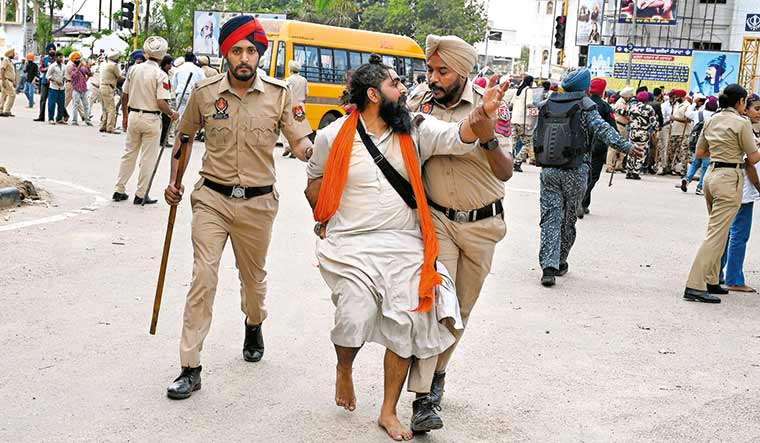The Aam Aadmi Party government in Punjab led by Bhagwant Mann chose to join hands with the Union government to nab pro-Khalistan leader Amritpal Singh and his associates, despite the frosty ties between the AAP and the BJP. The Mann government was startled by the revelation that Amritpal, aided by Pakistan’s ISI, was trying to form his own armed militia called the Anandpur Khalsa Fauj.
The top security brass in Delhi has been watching Amritpal's rise for a while, but they chose to give the local police the opportunity to take the initiative. But with the security situation getting out of hand, the Intelligence Bureau and the National Investigation Agency have stepped in, backed by a political decision made at the highest level to assist the local police. Leading the operation is Punjab DGP Gaurav Yadav, a 1992-batch IPS officer, who is known for his suave style and swift moves. He leads an experienced counter-intelligence team that is tracking and tracing Amritpal and his associates, using technological tools and traditional policing methods.
The investigation is supported by the NIA, led by director-general Dinkar Gupta, a 1987-batch IPS officer, who was appointed as chief of Punjab Police in 2019. He was dropped from the post by the Congress government led by Charanjit Singh Channi in October 2021. Gupta was brought to Delhi to head the NIA in 2022. He had pioneered Punjab Police’s efforts to bust gangster-terrorist networks by making the force tech savvy. His involvement has made co-ordination easier for his former colleagues.
Just as the joint operation was about to deliver results, Amritpal managed to give his pursuers the slip, putting the pressure back on the police. "It is a critical time and I hope there is no blame game. The joint operations should continue to ensure the desired result,” said a senior official in Delhi. “Once the network is busted, the criminal elements will stop aligning with Amritpal.”
There is also much work ahead for Central intelligence agencies who have detected a sustained pro-Khalistan online campaign in support of Amritpal―coming from Canada, the US, the UK, Australia and New Zealand. Even as internet services were shut down in Punjab, the pro-Khalistani alliance remained active abroad, throwing up links to the ISI-backed conspiracy of destabilising the border state. Most of the tweets supporting Amritpal and Khalistan have come from Canada and the US, where the organisation Sikhs for Justice is active.
A similar wave was seen in 2020 during the time of the farmers' protest, and pro-Khalistani accounts created at that time are still active.“On the face of it, everything seems independent to each other. But it has actually been part of a larger objective of the toolkit,” said an intelligence official. Several entities close to Amritpal also have links with the Khalistan Liberation Force (KLF), which is banned by the Union home ministry. The KLF is run by Pakistan-based Lakhbir Singh Rode, the nephew of slain Sikh leader Jarnail Singh Bhindranwale. Amritpal has been heavily influenced by the life and ideology of Bhindranwale.
In the notification banning the KLF, the home ministry blamed the outfit for killing innocent people, targeting police officers, bombing civilian targets, collecting funds for terrorist activities, bank robberies and for assassination attempts on important government functionaries. According to intelligence officials, Lakhbir's close associates played an important role in Amritpal's steady growth as a top rebel leader.
While Lakhbir's family in Punjab does not support Amritpal, the police is investigating his links with some members of the Waris Punjab De (WPD) founded by Deep Sidhu. After Sidhu's death in a road accident, Amrtipal has taken over the organisation. Intelligence agencies are worried that the ISI is using WPD members to influence Punjab's disgruntled youth. An ISI officer code-named “Mirza” is learnt to have overseen WPD's funding activities since Amritpal came to India. Hawala networks are being used, said investigators, adding that a probe is on to bust these networks.
The KLF and Lakhbir have been on the NIA's radar after multiple terror attacks in Punjab, like the 2021 IED blasts in a Ludhiana court complex. A year later , the name of Harwinder Singh Rinda, a member of the banned Babbar Khalsa International (BKI), came up in connection with the May 2022 grenade attacks on the intelligence headquarters of Punjab Police in Mohali. Rinda's alleged game plan was to tap into Punjab's gangster-terrorist network and the police is investigating possible links between him and Amritpal's associates.
The NIA has evidence of Lakhbir being assisted by cross-border smugglers to bring weapons into India. The fact that Amritpal's armed militia was carrying unlicenced weapons like 12 bore double-barrel guns has led investigators to probe his links with the BKI and the KLF. Sources said more details of the ISI's penetration into WPD activities would become clear once Amritpal was arrested and interrogated. So far, no direct handler has been identified, but several call records point towards the ISI's involvement.
Sidhu had brought the WPD under the scanner with his tractor rally on January 26, 2021, leading to unprecedented violence at the Red Fort, but his successor Amritpal has reshaped the organisation into one with suspected links to banned outfits and foreign entities which are now targeting Indian missions abroad.


